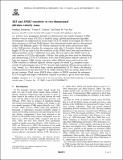| dc.contributor.author | Van Ark, Emily M. | |
| dc.contributor.author | Cormier, Vernon F. | |
| dc.contributor.author | Rondenay, Stephane | |
| dc.date.accessioned | 2011-01-07T21:05:52Z | |
| dc.date.available | 2011-01-07T21:05:52Z | |
| dc.date.issued | 2010-04 | |
| dc.date.submitted | 2009-11 | |
| dc.identifier.issn | 0148–0227 | |
| dc.identifier.uri | http://hdl.handle.net/1721.1/60410 | |
| dc.description.abstract | Seismic wave propagation through two-dimensional core-mantle boundary (CMB) ultralow-velocity zones (ULVZs) is modeled using a global pseudospectral algorithm. Seismograms are synthesized for several types of ULVZ models to investigate the effect of these structures on SKS and SPdKS phases. One-dimensional models and two-dimensional models with different, quasi-1-D velocity structures on the source and receiver sides of the CMB provide a baseline for comparison with other 2-D models. Models with finite length ULVZs are used to test the sensitivity of the SPdKS travel time and waveform to different portions of the P diffracted wave path. This test shows that SPdKS waves are only sensitive to ULVZs with lengths >100 km. Our results give three tools for identifying and characterizing 2-D ULVZ structures. First, dual SPdKS pulses indicate exposure to at least two separate CMB velocity structures, either different source and receiver-side CMB velocities or different adjacent velocity regions for which Pdiff inception occurs outside of and propagates into a ULVZ. Second, high-amplitude SKS precursors indicate a very “strong” (i.e., thick and/or large velocity perturbations) ULVZ. Hence, the absence of SKS precursors in most previous ULVZ studies indicates that very strong, sharp ULVZs are not common. Third, mean SPdKS delays relative to PREM constrain the minimum ULVZ strength and length combinations required to produce a given travel time delay. | en_US |
| dc.description.sponsorship | National Science Foundation (U.S.) (EAR 02-29586) | en_US |
| dc.description.sponsorship | National Science Foundation (U.S.) (EAR 07-38492) | en_US |
| dc.description.sponsorship | Massachusetts Institute of Technology. Kerr-McGee Development Chair | en_US |
| dc.description.sponsorship | Woods Hole Oceanographic Institution. Deep Ocean Exploration Institute | en_US |
| dc.language.iso | en_US | |
| dc.publisher | American Geophysical Union | en_US |
| dc.relation.isversionof | http://dx.doi.org/10.1029/2009JB006733 | en_US |
| dc.rights | Article is made available in accordance with the publisher's policy and may be subject to US copyright law. Please refer to the publisher's site for terms of use. | en_US |
| dc.source | MIT web domain | en_US |
| dc.title | SKS and SPdKS sensitivity to two-dimensional ultralow-velocity zones | en_US |
| dc.type | Article | en_US |
| dc.identifier.citation | Rondenay, S., V. F. Cormier, and E. M. Van Ark (2010). "SKS and SPdKS sensitivity to two-dimensional ultralow-velocity zones." J. Geophys. Res., 115, B04311, doi:10.1029/2009JB006733. ©2010 by the American Geophysical Union. | en_US |
| dc.contributor.department | Massachusetts Institute of Technology. Department of Earth, Atmospheric, and Planetary Sciences | en_US |
| dc.contributor.approver | Rondenay, Stephane | |
| dc.contributor.mitauthor | Van Ark, Emily M. | |
| dc.contributor.mitauthor | Rondenay, Stephane | |
| dc.relation.journal | Journal of Geophysical Research | en_US |
| dc.eprint.version | Final published version | en_US |
| dc.type.uri | http://purl.org/eprint/type/JournalArticle | en_US |
| eprint.status | http://purl.org/eprint/status/PeerReviewed | en_US |
| dspace.orderedauthors | Rondenay, Stéphane; Cormier, Vernon F.; Van Ark, Emily M. | en |
| mit.license | PUBLISHER_POLICY | en_US |
| mit.metadata.status | Complete | |
